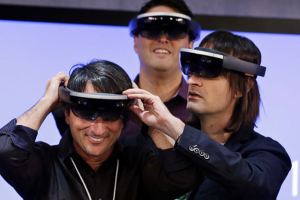Earlier this week, Microsoft held a special event to announce more details on the new Windows 10 operating system for desktops and laptops. But the exciting news is that Windows 10 isn't just for desktops and laptops; it's for mobile devices, too. And it's free!
While Windows 8 started the introduction of desktop to mobile devices, Windows 10 takes things a few steps further with a build made specifically for your smartphones and tablets under eight inches. The software reorganizes the interface to replicate the old Windows Phone system, but includes other goodies like synced notifications and better integration with Skype, which Microsoft now owns.
This focus on integrating desktops and mobile devices was long overdue as companies like Google and Apple have already made greater strides in understanding that our tech connection to the world doesn't end when we step away from our desk.
This includes a real push to get apps on your phones to work seamlessly with apps on your desktop, including Office that allows you to run Powerpoint from your phone, and the allowance of the entire Microsoft Word engine to be integrated into the universal Outlook email app.
And as many already knew was coming, thanks to some early leaks, Internet Explorer is being replaced with a brand new browser that is so far codenamed Project Spartan. Although Microsoft previously insisted that IE would not be going away completely, it looks like Spartan will be replacing the old browser.
Spartan will allow annotation of web pages with a stylus or other touchscreen markings, allow snippets of webpages to be cut out and shared just like a newspaper or magazine, and it will also allow a special reading mode that removes display ads.
Spartan, and most other parts of Windows 10, has Microsoft's Siri-like digital assistant, Cortana, built right in. This means that Cortana will be available for the first time to Windows desktop users, allowing sophisticated voice commands to be used across both desktop and mobile platforms.
For gamers, the big announcement was the further integration of the Xbox and the PC with a new Xbox app right on the PC. This allows all the features of Xbox One, like messages, friends list, games streaming, and activity feed, to be right there on your desktop without the need to head over to the Xbox website and login every time. It's just built right in.
And just like how Sony made PlayStation 4 games streamable to the PS Vita, Microsoft is making Xbox One games streamable to the SmartGlass mobile app. This is certainly exciting news as hardware advancements allow tablets and hybrids to become more capable of playing full Xbox games.
But perhaps the most surprising news of the event was Microsoft's foray into virtual reality. It should come as no surprise, really, as the Oculus Rift has already gained so much attention in the last few years, but Microsoft's HoloLens is a transparent lens affixed to a headset that allows holographic overlays for everything you see in the real world.
Examples given at the demonstration included an architect walking through schematics while at the build site, and plumbers drawing plans for faucets while working remotely.
All of these features, and more, will be available with Windows 10 at launch, although the exact timeframe wasn't given beyond "later this year." Windows 10 will be completely free for all Windows 7, Windows 8.1, and Windows Phone 8.1 users for the first 12 months after the OS launches.

















